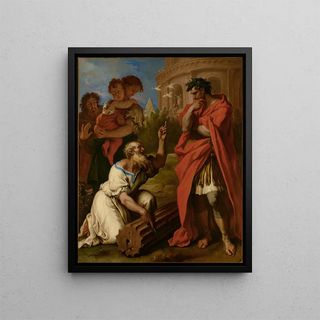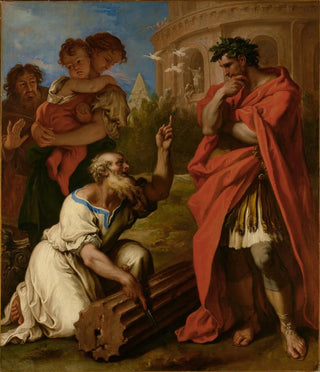Art print | Tarquin the Elder consulting Attus Navius - Sebastiano Ricci


View from behind

Frame (optional)
In the vast panorama of art history, certain works stand out for their ability to capture historic moments while infusing their subjects with an almost mythical dimension. "Tarquin the Elder consulting Attus Navius" by Sebastiano Ricci is one of these masterpieces. This piece, imbued with dramatic intensity and rich storytelling, evokes a significant episode from ancient Rome. It transports us to a world where power, superstition, and wisdom intersect, inviting reflection on choices and their consequences. The scene depicts King Tarquin, an iconic figure in Roman history, in the midst of consultation with the famous augur Attus Navius. This moment, charged with tension and mystery, truly reflects the beliefs and traditions of the time.
Style and uniqueness of the work
Ricci's style is characterized by a flamboyant baroque, where light and shadow play a crucial role in the composition. In this artwork, the vibrant color palette and the meticulous details of costumes and character expressions reveal impressive technical mastery. The figures are arranged dynamically, creating a movement that guides the viewer’s eye across the scene. The expressive gestures of the characters, especially that of Tarquin, convey emotional intensity that enhances the visual impact of the piece. Ricci, as a true visual storyteller, manages to transmit not only the action but also the atmosphere of tension that prevails within this augural consultation. The composition is thus a harmonious marriage between realism and idealization, typical of baroque art, where each element contributes to the overall narrative.
The artist and his influence
Sebastiano Ricci, an emblematic figure of the 18th century, left an indelible mark on the art world. Born in Venice, he established himself as a master of the baroque, influenced by the great artists of his time while developing a personal style. His ability to capture light and play with shadows inspired many artists, both contemporaries and followers. Ricci often drew inspiration from mythology and the

Matte finish

View from behind

Frame (optional)
In the vast panorama of art history, certain works stand out for their ability to capture historic moments while infusing their subjects with an almost mythical dimension. "Tarquin the Elder consulting Attus Navius" by Sebastiano Ricci is one of these masterpieces. This piece, imbued with dramatic intensity and rich storytelling, evokes a significant episode from ancient Rome. It transports us to a world where power, superstition, and wisdom intersect, inviting reflection on choices and their consequences. The scene depicts King Tarquin, an iconic figure in Roman history, in the midst of consultation with the famous augur Attus Navius. This moment, charged with tension and mystery, truly reflects the beliefs and traditions of the time.
Style and uniqueness of the work
Ricci's style is characterized by a flamboyant baroque, where light and shadow play a crucial role in the composition. In this artwork, the vibrant color palette and the meticulous details of costumes and character expressions reveal impressive technical mastery. The figures are arranged dynamically, creating a movement that guides the viewer’s eye across the scene. The expressive gestures of the characters, especially that of Tarquin, convey emotional intensity that enhances the visual impact of the piece. Ricci, as a true visual storyteller, manages to transmit not only the action but also the atmosphere of tension that prevails within this augural consultation. The composition is thus a harmonious marriage between realism and idealization, typical of baroque art, where each element contributes to the overall narrative.
The artist and his influence
Sebastiano Ricci, an emblematic figure of the 18th century, left an indelible mark on the art world. Born in Venice, he established himself as a master of the baroque, influenced by the great artists of his time while developing a personal style. His ability to capture light and play with shadows inspired many artists, both contemporaries and followers. Ricci often drew inspiration from mythology and the






